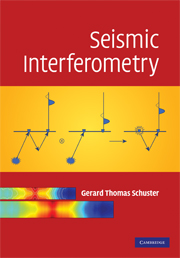Book contents
- Frontmatter
- Contents
- Preface
- 1 Introduction
- 2 Reciprocity equations of convolution and correlation types
- 3 VSP → SWP correlation transform
- 4 VSP → SSP correlation transform
- 5 VSP → SSP convolution transform
- 6 SSP → SSP correlation transform
- 7 VSP → VSP correlation transform
- 8 SSP → VSP → SWP transforms
- 9 Traveltime interferometry
- 10 Stochastic interferometry
- 11 Interferometric source estimation
- 12 Body wave earthquake interferometry
- References
- Index
1 - Introduction
Published online by Cambridge University Press: 15 October 2009
- Frontmatter
- Contents
- Preface
- 1 Introduction
- 2 Reciprocity equations of convolution and correlation types
- 3 VSP → SWP correlation transform
- 4 VSP → SSP correlation transform
- 5 VSP → SSP convolution transform
- 6 SSP → SSP correlation transform
- 7 VSP → VSP correlation transform
- 8 SSP → VSP → SWP transforms
- 9 Traveltime interferometry
- 10 Stochastic interferometry
- 11 Interferometric source estimation
- 12 Body wave earthquake interferometry
- References
- Index
Summary
For more than a century, scientists and engineers have used the interference of light waves to assess the optical properties of an object (Lauterborn et al., 1993; Monnier, 2003; Saha, 2002). A well-known example of an optical interference pattern is Newton's rings, where light waves reflecting from two closely spaced surfaces interfere to form a ring pattern as shown in Figure 1.1.
The intensity pattern |D(A)|2 is known as an interferogram, where D(A) describes the brightness field at a location A on the top of the lens surface. The interferogram characterizes the interference between the upgoing reflections from the bottom of the lens at B and from the glass pane at C. Dark rings correspond to zones where the reflections with raypaths ABA and ACA are out of phase resulting in destructive interference, while the bright rings correspond to the in-phase reflections that give rise to constructive interference. The phase is controlled by the lens thickness, which thickens toward the center, so that any departures from perfect circular rings indicate subtle variations from an ideal lens geometry. As an example, Figure 1.2 shows an interferogram that reveals micron-sized imperfections in a cut diamond, where micron-deep pits show up as triangular interference patterns.
Seismic interferometry
Analogous to optical interferometry, seismic interferometry estimates the detailed properties of the Earth by analyzing the interference patterns of seismic waves. These patterns are constructed by correlating and summing pairs of seismic traces with one another to robustly image the Earth's elastic properties. As an example, consider the Figure 1.3a Earth model where single-channel seismic traces are recorded over a sand lens underlying a complex overburden.
- Type
- Chapter
- Information
- Seismic Interferometry , pp. 1 - 29Publisher: Cambridge University PressPrint publication year: 2009
- 4
- Cited by



